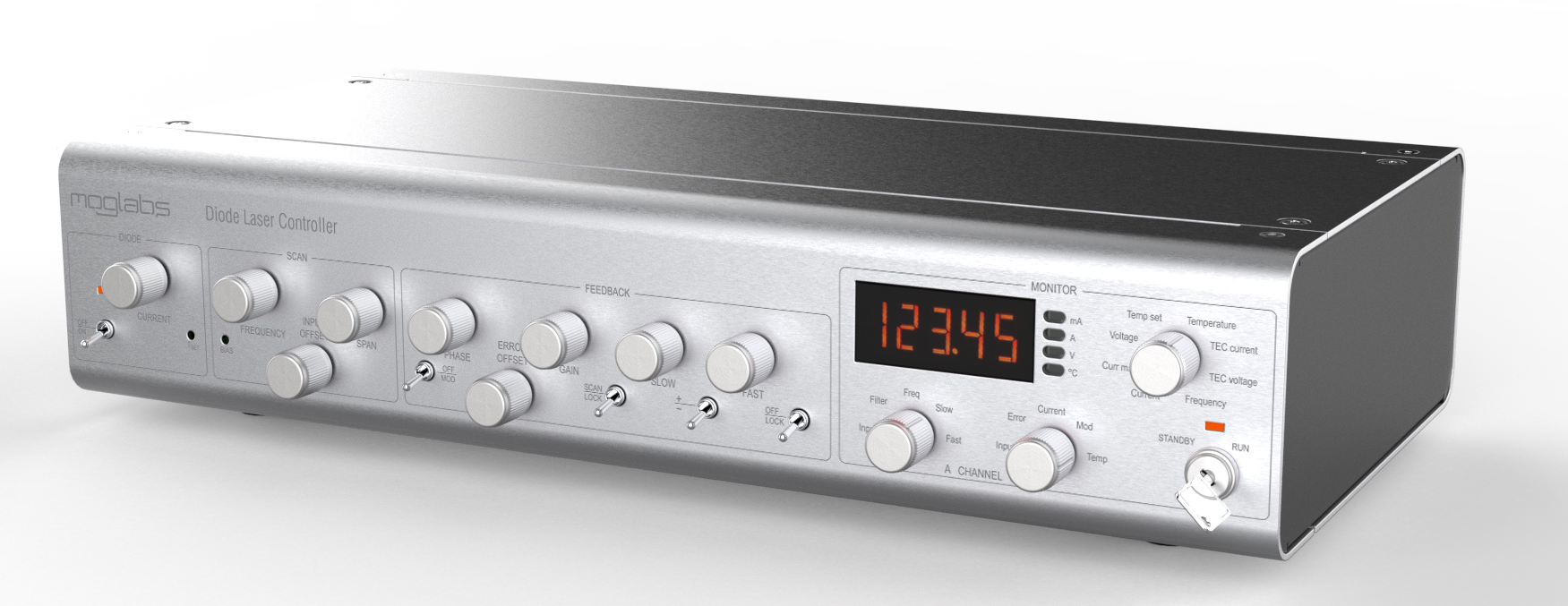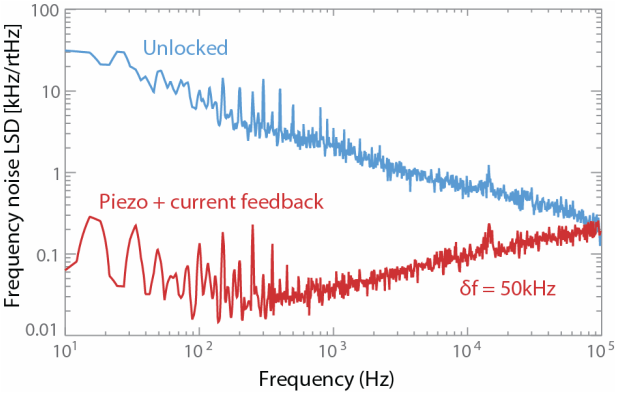
The MOGbox DLC202 laser diode controller is the world's first all-in-one controller for driving and frequency locking an external cavity diode laser. Every model includes:
- Ultra-low noise diode current source, < 100pA/rtHz, DC to 1MHz
- Temperature controller with Peltier TEC driver
- Scan generator
- Two high-voltage piezo drivers
- Differential low-noise photodetector, 700kHz bandwidth
- Demodulator (lock-in amp)
- AC modulation source (250kHz, 50mA, e.g. for Zeeman dither coil)
- Servo feedback loop filter circuits
- Ergonomic controls, including 4.5 digit display, oscilloscope selectors
- In-laser connection & protection board with high bandwidth modulation
- Full set of cables and 120 page detailed user-manual
All in one box, based on a single 10-layer PCB (plus the external photodetector and protection/connection circuit board for the laser head).
We have used design principles developed by audio (hifi) fanatics, combined with expertise from designing complex 24-layer circuit boards for the optical fibre communications industry. Test results are superior to anything else available commercially; for example, linewidths as low as 5kHz.
Discover more about our tunable lasers.
See sub-5 kHz ECDL linewidth as demonstrated by a customer using a MOGLabs DLC controller!
DLC Datasheet
Legacy Manuals
Request a quote
Request support
Ultra-low noise current source
Dual feedback servos
Modulator driver
Temperature controller
Lock-in amplifier
Piezo drivers
Sweep ramp generator
Features
100, 200, 250, 500mA max current
High compliance voltage
Rack mount kits
Options
Performance

Current noise
The diode injection current noise is so low that in almost all cases, the laser performance is determined by the optical characteristics of the external cavity, not the MOGLabs controller. The curve below shows the diode injection current noise (or lack thereof). Measured at 50mA into 50 ohms (orange trace) and zero current (blue trace). The current noise level is well below -145dBm (0.25nA/√Hz) for nearly all of the spectrum (measured at 1Hz RBW).

Frequency noise
Typical frequency noise spectrum with a CEL001 cateye laser. The first resonance with our CEL002 laser occurs at around 30kHz.

Linewidth
The figure below shows a self-heterodyne beatnote for a single diode laser, locked to a rubidium transition. The beatnote width was roughly 80kHz (FWHM), 35kHz (rms). Our linewidth measurements are described in Appl. Opt., 48 6961-6966 (2009).

In another experiment, we demonstrated a wide-bandwidth frequency locking technique based on electromagnetically induced transparency (EIT) using FM sideband locking. The figure below shows the beatnote frequency with two lasers locked to transitions in Rb87, with different hyperfine ground states separated by 6.8GHz. One laser was locked to a saturated absorption peak, the other to the EIT resonance. The beatnote, which is a measure of the relative frequency stability, has a width of 4kHz for a 22.5s average, and less than 1kHz for a single sweep of 0.2s. The work was published in Appl. Phys. Lett., 90 171120 (2007).

Scan range
The scan range depends very much on the mechanical and optical design of your laser. Using a standard consumer laser diode for cd-rom writing applications, without special coatings, and a low-efficiency 1800 l/mm grating, scans of a few GHz are typical in a Littrow configuration. Increased scan range is possible by careful desigsn of the pivot point of the grating, so that the frequency change due to the change in cavity length closely matches the frequency change due to the change in grating angle. See for example our paper Appl. Opt., 48 6692-6700 (2010).
We can instead ramp the diode injection current and cavity length (piezo) together. With standard uncoated diode, low-feedback grating and Littrow configuration, we can scan up to 40GHz without mode-hops. The figue below shows a 10GHz saturated absorption spectrum for the 780nm rubidium transition, with all hyperfine transitions for both naturally occurring isotope, together with locking error signal, using a standard DLC.
With the DLC and our latest Littrow laser with dual piezos to translate and rotate the grating, the mode-hop-free scan range increases to more than 100GHz.

Drift
The frequency of a 671nm cateye laser (CEL002) was measured over several days as the
room temperature and air pressure varied. The data below shows a 24 hour period in
which the temperature changed by more than 2°C and the air pressure by several mbar.
The laser frequency was within a band of ± 100 MHz, i.e. around 100 MHz/°C.
